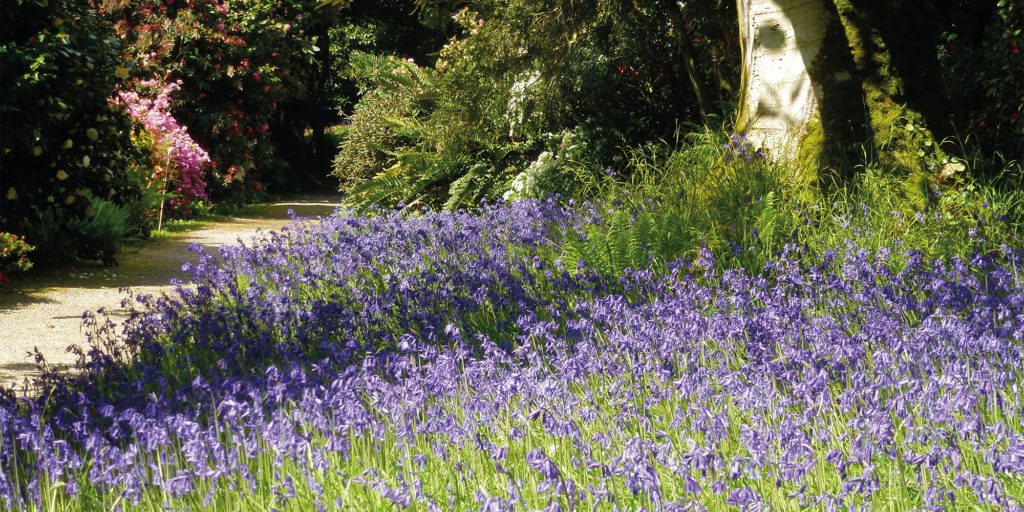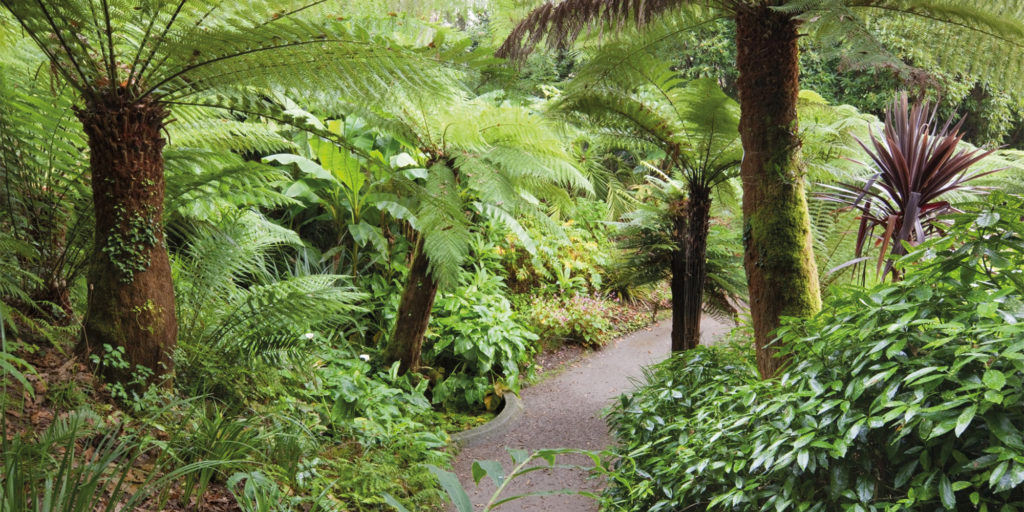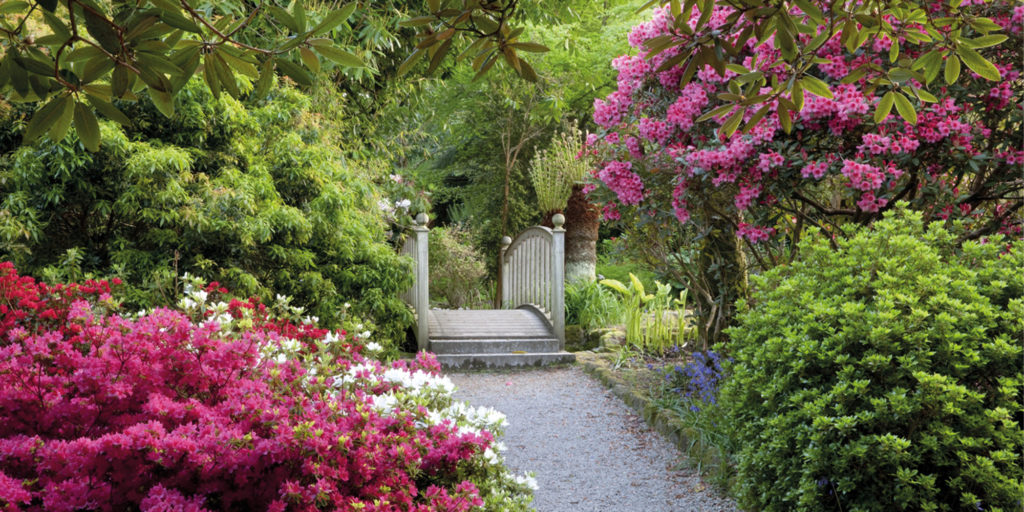

Paradise in bloom
A glance behind the ivy-covered door into some of Cornwall’s most cherished secret gardens.
Nestled along the glistening coast and hidden in lush woodlands amongst the ancient remains of Cornish history can be found some of the county’s proudest living treasures. We’re very lucky to now have access to so many gardens which were once private spaces for the fortunate families that owned the rich and prosperous land, and it’s down to these green-fingered visionaries that we owe our thanks for the carefully tended and thriving gardens we’re able to visit today.
In 1762 the Fox’s, a noted Quaker family, established themselves in Falmouth and are responsible for more than one of the shining gems we have now, including Penjerrick and Trebah, but most particularly the colourful and flourishing grounds that are Glendurgan Garden and Estate. Alfred Fox set up home here with his wife and subsequent family of 12, and began to develop the layout of the garden paths which remain today, along with the iconic cherry laurel maze and orchards. The family’s investments in a ship agency presented a convenient opportunity for the acquirement of rare and exotic plant species to populate the grounds, many of which have been maintained to this day. Alfred’s fifth son George was a keen botanist, and after inheriting the estate in 1890 began to expand the plant collections with particular emphasis on Conifers and tender Rhododendrons. His eldest son, Cuthbert, was passed the green-fingered torch in 1931 and continued to develop the gardens with his wife Moyra for the next 30 years. In 1962, marking the bicentennial of the establishment of the family in Falmouth, Cuthbert, Moyra and their son Philip entrusted Glendurgan to the National Trust, so that the maintenance of grounds and estate could be continued and the rare beauty of this beloved family heirloom preserved and enjoyed by all.
Today Glendurgan offers a vibrant Camellia walk, an olive grove and apple orchard home to local varieties of apples, figs, pecans, pears and citrus fruits, as well as three beehives with an active colony of honeybees. You can take a stroll beneath the blossoming cherry trees on your way to the ancient cherry laurel hedge maze and quite literally lose yourself in the arms of the garden. But in the heart of it all, at the top of the valley garden, you can find what the National Trust affectionately refers to as ‘the grandfather of Glendurgan’. At almost 190 years old, the iconic tulip tree (Liriodendron tulipifera) is the oldest and most impressive tree on the grounds, boasting bright tea cup flowers in hues of lime green and orange in late June, and as autumn approaches the giant green leaves take on bright gold tones and signal the end of another year at Glendurgan, as the garden prepares to close for winter.
Tucked away in the woodland of Penwith lies another hidden gem, famed for its award-winning floral collections and impressive exotic tree specimens. In 1850, Edward Bolitho bought the land known as ‘Trewidden Bal’ which is now known to us as Trewidden House and Garden. The gardens are situated on the site of an ancient opencast tin mine dating all the way back to Roman times, evidence of which can still be seen today! Edward is responsible for planting the cover of woodland that keeps this secret garden from the outside world, before establishing newly introduced plants from Asia and the Southern Hemisphere throughout the grounds. But this visionary did not work alone, and was very fortunate to have the expertise of his head gardener, George Maddern, who worked to plant and shape the garden for 45 years to roughly the size it is today. Edward’s son Thomas would go on to continue the work laid down by his father, and make the decision in 1902 to fill the old opencast mine with tree ferns (Dicksonia antarctica), newly imported from Australia by Treseders nursery, creating the Tree Fern Dell. Thomas’ creativity and hard work has resulted in what is now considered the best stand of tree ferns in the Northern Hemisphere, and is a breathtaking sight to behold. Mary Williams, daughter of Thomas Bolitho, returned to her enchanting childhood home after the death of her husband in 1955 and became a huge influence on the development of the garden, planting the striking Magnolia hypoleuca that remains on the North Walk herself. Now the largest of its kind in the UK, it has also been designated as a Champion Tree! Mary spent the rest of her days gardening with enthusiasm and joy in the wooded wonderland she was raised in.
Today, Trewidden is owned by Alverne Bolitho, a cousin of Mary’s who inherited the property when she passed away in 1977. He continues to develop the garden alongside his Head Gardener Richard Morton and the team, with the charming aim of keeping the garden a place of ‘peace and beauty, of constant surprise and delight’. Jenny Olds, Land Agent, remarks on this: “Time and time again our visitors remark how Trewidden is a place of calm and tranquillity. Wandering under the lofty trees and through the maze of paths around the plant collections, which are all spectacular in their own way when in bloom, always seems to restore the soul!”
Under Alverne’s stewardship the gardens were opened to the public for all to enjoy this delightful feeling. Take in the colours and scents of over 250 varieties of Camellia, bask in the glory of the five Champion Magnolia trees, and feel like a Lilliputian under the towering soft tree ferns, settled for over a century in the bowl of the mine’s remains in a handmade paradise.
Overlooking the quaint village of St Mawes, with an overwhelming coastal view, sits the comparatively modern Lamorran Gardens, established much more recently in 1982, when Robert and Maria-Antoinette Dudley-Cooke acquired an overgrown, steeply sloping stretch of pure potential. Memories of their past travels to the gardens of La Montella on the Italian isle of Ischia planted a seed that, with hard work and creative determination, would turn to reality for this budding couple. Images of a romantic terraced garden with curving paths and occasional reveals of the sea would form a template for Robert, who transplanted a large collection of Rhododendrons and evergreen azaleas to make up the early plantings. Drawing inspiration from the spirit of Japanese, Mediterranean, and English gardens, Lamorran House Gardens began to take shape. After an expansion in the mid-nineties that essentially doubled the size of the garden, Head Gardener Mark Brent offered his expertise for the next 20 years and the grounds began to take the shape that we can see today. The garden has an unusual benefit with the sea right at its door, creating an atmosphere that wards off any frost and allows for a multitude of exotic and unusual planting choices. Lamorran also boasts a healthy collection of tree ferns and palms that flourish in this benign microclimate.
This subtropical, Italianate inspired garden radiates warm visions of the Mediterranean as you wander among the temples and archways, and transports you to Venice as you walk over the bridge and lean out to look across the bay. Explore the areas of lush woodland, and discover the Japanese inspired water garden. Overall, Lamorran Gardens truly embodies the guiding principle behind its design, to create ‘tranquillity and beauty in harmony with nature’.
A multitude of blossoming gardens are open to us this season, and whether you’re looking for towering exotic flora to take your breath away, an insight into a secret-garden of childhood dreams, or an element of warm, far-away lands in a pocket utopia, don’t miss out on visiting a secret Cornish paradise coming into bloom this summer.
Discover more
For opening times, bookings and further information on all National Trust locations, visit www.nationaltrust.org.uk
Discover more
In 2018 Trewidden was awarded the International Camellia Society ‘Garden of Excellence’ award. If you don’t mind keeping your pooch on a lead, they can join you on your Trewidden explorations!
Did you know?
Those mentioned in our cover feature are but a small selection of the fantastic gardens that call Cornwall home. Here are some of our other favourites that are well worth pencilling into your itinerary!
Trebah Garden
www.trebahgarden.co.uk
Lost Gardens of Heligan
www.heligan.com
Eden Project
www.edenproject.com
Caerhays
visit.caerhays.co.uk
Trewithen Gardens
www.trewithengardens.co.uk
Tremenheere Sculpture Garden
www.tremenheere.co.uk
Enys Gardens
www.enysgardens.org.uk
Bonython Estate Gardens
www.bonythonmanor.co.uk
Trelissick Gardens
www.nationaltrust.org.uk/trelissick
Trengwainton Gardens
www.nationaltrust.org.uk/trengwainton-garden









